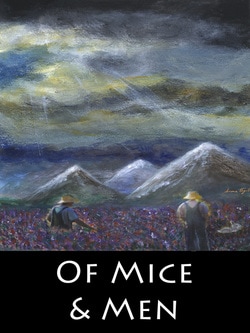Reviewed by LindaAnn Loschiavo for L’Idea
“The best laid schemes o’ mice an’ men / Often go awry.” — — from “To a Mouse” by Robert Burns

When writing his novella “Of Mice and Men,” John Steinbeck [1902—1968] based the narrative on his own experiences as a bindlestiff during the 1920s. Published in 1937, the story is set in California’s Great Valley, whose lush agricultural bounty required the hiring of migrant workers to bale barley, bag onions, pick fruit, and help with harvesting.
Loneliness is inherent in a rootless, peripatetic lifestyle, however, two migrant ranch hands George Milton (Thomas R. Gordon) and Lennie Small (Alexander Kafarakis) have decided to team up. Physically strong and capable of repetitious toil, dim-witted Lennie is hired easily with George as his fast-talking spokesman. Nevertheless, George is fond of reminding his troublesome cohort how he’d be better off alone. Under the direction of Mr. Gordon, these speeches are delivered with rueful affection and Lennie beams happily, undaunted by the familiar scolding. George has plenty of speeches in the play, most memorably the fanciful narrative about buying their own place where Lennie can tend the rabbits, which marks him as a nourisher of the non-truths they both need to survive.
But Steinbeck also layers serious foreshadowing into his first scene. As George orders him to throw away a dead mouse he’s been petting, Lennie admits he loves to stroke soft things yet invariably, unintentionally kills them. They both revisit the incident of the lady in red, whose rustling taffeta Lennie tried to fondle, provoking screams and an expulsion from Weed, California. This back history is there for one reason: to warn the audience that past is prologue. 
As Steinbeck propels his bindlestiffs into their next situation, he surrounds them with several ranch hands who neither oppose them nor do them harm. This clutters the stage with an assortment of males who have few lines and who are just slightly more than window dressing. In the cast of ten, these four characters will impact on George and Lennie: Candy, an old handyman with a missing hand and an old dog; Curley, the boss’s mean-spirited son, who is a jealous newlywed; Curley’s flirtatious wife; and Crooks, the lonely, black stable-hand.
Scenes which might have resonated with a reader in the novella are dramatically inert onstage because there’s more tell than show and very few surprises. Excellent acting could perhaps balance this flaw in a production but many cast members are merely adequate instead of riveting.
Thomas R. Gordon, Artistic Director of The Onomatopoeia Theatre Company has given himself perhaps too much to do: directing, handling the sound design, and co-starring. As a stiff and unspontaneous George Milton, unfortunately, his line-reading is flat, his comfort in the character nonexistent. Alexander Kafarakis turns in an impressive, poignant performance as the mentally challenged Lennie Small. In this tricky, challenging role, he steals the show. Of all the actors, Xavier Reminick is the most physically aware. He uses his body well to convey the distress of the tightly coiled Curley, restlessly spying on his wife.
The sound design by Mr. Gordon was well-crafted and used to good effect.
Light Design by Pamela Pangaro and Scenic Design by Mitchell Ost were kept simple but did the job. Costume Designer Al Malonga gave the males the realistic look of Depression Era farm hands and overalls for Lennie was an excellent choice. However, the attire of Curley’s wife was hit and miss. Her first appearance in a frilly cowgirl shirt and denim pants worked well on the tall, slim, leggy figure of actress Lisa Monde but the tan high heels were a false note and the style was not from the 1930s. All of her footwear, in fact, was incorrect for the period as well as her hairstyle.
The Onomatopoeia Theatre Company intends to bring back other classics at the Gene Frankel Theatre and it will be interesting to see what’s coming up next in their season. But I hope they increase the point size of the type so I can read the next stagebill without binoculars.
Cast
Thomas R. Gordon – GEORGE
Alexander Kafarakis – LENNIE
Jim DiMunno – CANDY
Joe Sexton – BOSS
Xavier Reminick – CURLEY
Lisa Monde – CURLEY’S WIFE
Jamie Geiger – SLIM
Samuel Shurtleff – CARLSON
Thaddaeus J. Abbott – WHIT
Dwaynne Walker-Dixon – CROOKS
Shanti – CANDY’S DOG
JOHN STEINBECK’S “OF MICE AND MEN”
APRIL 7 to 29, 2017 at GENE FRANKEL THEATRE, 24 Bond Street, NYC







